[English] 日本語
 Yorodumi
Yorodumi- PDB-2ec9: Crystal structure analysis of human Factor VIIa , Souluble tissue... -
+ Open data
Open data
- Basic information
Basic information
| Entry | Database: PDB / ID: 2ec9 | ||||||
|---|---|---|---|---|---|---|---|
| Title | Crystal structure analysis of human Factor VIIa , Souluble tissue factor complexed with BCX-3607 | ||||||
 Components Components |
| ||||||
 Keywords Keywords | BLOOD CLOTTING / protein-cofactor complex / FVIIa and souluble tissue factor / inhibitor | ||||||
| Function / homology |  Function and homology information Function and homology informationactivation of plasma proteins involved in acute inflammatory response / activation of blood coagulation via clotting cascade / coagulation factor VIIa / response to Thyroid stimulating hormone / response to astaxanthin / response to thyrotropin-releasing hormone / response to 2,3,7,8-tetrachlorodibenzodioxine / response to carbon dioxide / response to genistein / serine-type peptidase complex ...activation of plasma proteins involved in acute inflammatory response / activation of blood coagulation via clotting cascade / coagulation factor VIIa / response to Thyroid stimulating hormone / response to astaxanthin / response to thyrotropin-releasing hormone / response to 2,3,7,8-tetrachlorodibenzodioxine / response to carbon dioxide / response to genistein / serine-type peptidase complex / response to vitamin K / positive regulation of platelet-derived growth factor receptor signaling pathway / positive regulation of leukocyte chemotaxis / response to thyroxine / NGF-stimulated transcription / response to cholesterol / cytokine receptor activity / response to growth hormone / positive regulation of positive chemotaxis / Extrinsic Pathway of Fibrin Clot Formation / positive regulation of endothelial cell apoptotic process / positive regulation of blood coagulation / animal organ regeneration / positive regulation of TOR signaling / Transport of gamma-carboxylated protein precursors from the endoplasmic reticulum to the Golgi apparatus / Gamma-carboxylation of protein precursors / Removal of aminoterminal propeptides from gamma-carboxylated proteins / positive regulation of endothelial cell proliferation / serine-type peptidase activity / BMAL1:CLOCK,NPAS2 activates circadian expression / positive regulation of interleukin-8 production / circadian rhythm / protein processing / phospholipid binding / Golgi lumen / response to estrogen / cytokine-mediated signaling pathway / positive regulation of angiogenesis / blood coagulation / response to estradiol / : / protease binding / vesicle / response to hypoxia / positive regulation of cell migration / endoplasmic reticulum lumen / signaling receptor binding / external side of plasma membrane / serine-type endopeptidase activity / calcium ion binding / positive regulation of gene expression / cell surface / extracellular space / extracellular region / membrane / plasma membrane Similarity search - Function | ||||||
| Biological species |  Homo sapiens (human) Homo sapiens (human) | ||||||
| Method |  X-RAY DIFFRACTION / X-RAY DIFFRACTION /  MOLECULAR REPLACEMENT / Resolution: 2 Å MOLECULAR REPLACEMENT / Resolution: 2 Å | ||||||
 Authors Authors | Raman, K. / Yarlagadda, B. | ||||||
 Citation Citation |  Journal: Acta Crystallogr.,Sect.D / Year: 2007 Journal: Acta Crystallogr.,Sect.D / Year: 2007Title: Probing the S2 site of factor VIIa to generate potent and selective inhibitors: the structure of BCX-3607 in complex with tissue factor-factor VIIa. Authors: Krishnan, R. / Kotian, P.L. / Chand, P. / Bantia, S. / Rowland, S. / Babu, Y.S. | ||||||
| History |
|
- Structure visualization
Structure visualization
| Structure viewer | Molecule:  Molmil Molmil Jmol/JSmol Jmol/JSmol |
|---|
- Downloads & links
Downloads & links
- Download
Download
| PDBx/mmCIF format |  2ec9.cif.gz 2ec9.cif.gz | 140.3 KB | Display |  PDBx/mmCIF format PDBx/mmCIF format |
|---|---|---|---|---|
| PDB format |  pdb2ec9.ent.gz pdb2ec9.ent.gz | 107.2 KB | Display |  PDB format PDB format |
| PDBx/mmJSON format |  2ec9.json.gz 2ec9.json.gz | Tree view |  PDBx/mmJSON format PDBx/mmJSON format | |
| Others |  Other downloads Other downloads |
-Validation report
| Summary document |  2ec9_validation.pdf.gz 2ec9_validation.pdf.gz | 823.7 KB | Display |  wwPDB validaton report wwPDB validaton report |
|---|---|---|---|---|
| Full document |  2ec9_full_validation.pdf.gz 2ec9_full_validation.pdf.gz | 857.6 KB | Display | |
| Data in XML |  2ec9_validation.xml.gz 2ec9_validation.xml.gz | 31.3 KB | Display | |
| Data in CIF |  2ec9_validation.cif.gz 2ec9_validation.cif.gz | 42.2 KB | Display | |
| Arichive directory |  https://data.pdbj.org/pub/pdb/validation_reports/ec/2ec9 https://data.pdbj.org/pub/pdb/validation_reports/ec/2ec9 ftp://data.pdbj.org/pub/pdb/validation_reports/ec/2ec9 ftp://data.pdbj.org/pub/pdb/validation_reports/ec/2ec9 | HTTPS FTP |
-Related structure data
| Related structure data | 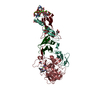 1danS S: Starting model for refinement |
|---|---|
| Similar structure data |
- Links
Links
- Assembly
Assembly
| Deposited unit | 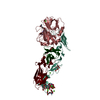
| ||||||||
|---|---|---|---|---|---|---|---|---|---|
| 1 |
| ||||||||
| Unit cell |
|
- Components
Components
-Coagulation factor ... , 2 types, 2 molecules LH
| #1: Protein | Mass: 16359.772 Da / Num. of mol.: 1 / Fragment: residues 1-142 Source method: isolated from a genetically manipulated source Source: (gene. exp.)  Homo sapiens (human) / Production host: Homo sapiens (human) / Production host:  |
|---|---|
| #2: Protein | Mass: 28103.256 Da / Num. of mol.: 1 / Fragment: residues 16-257 Source method: isolated from a genetically manipulated source Source: (gene. exp.)  Homo sapiens (human) / Production host: Homo sapiens (human) / Production host:  |
-Protein , 2 types, 2 molecules TU
| #3: Protein | Mass: 8715.800 Da / Num. of mol.: 1 / Fragment: residues 38-112 Source method: isolated from a genetically manipulated source Source: (gene. exp.)  Homo sapiens (human) / Production host: Homo sapiens (human) / Production host:  |
|---|---|
| #4: Protein | Mass: 13745.301 Da / Num. of mol.: 1 / Fragment: residues 91-210 Source method: isolated from a genetically manipulated source Source: (gene. exp.)  Homo sapiens (human) / Production host: Homo sapiens (human) / Production host:  |
-Sugars , 2 types, 2 molecules 
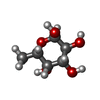

| #5: Sugar | ChemComp-ASO / |
|---|---|
| #6: Sugar | ChemComp-FUC / |
-Non-polymers , 3 types, 234 molecules 
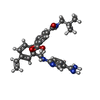



| #7: Chemical | ChemComp-CA / #8: Chemical | ChemComp-24X / | #9: Water | ChemComp-HOH / | |
|---|
-Experimental details
-Experiment
| Experiment | Method:  X-RAY DIFFRACTION / Number of used crystals: 1 X-RAY DIFFRACTION / Number of used crystals: 1 |
|---|
- Sample preparation
Sample preparation
| Crystal | Density Matthews: 2.66 Å3/Da / Density % sol: 53.74 % |
|---|---|
| Crystal grow | Temperature: 293 K / Method: vapor diffusion, hanging drop / pH: 6.5 Details: 14% (w/v)PEG 4K, 0.1M MgCl2, 0.1M ADA buffer, pH 6.5, VAPOR DIFFUSION, HANGING DROP, temperature 293K |
-Data collection
| Diffraction | Mean temperature: 98 K |
|---|---|
| Diffraction source | Source:  ROTATING ANODE / Type: RIGAKU RU200 / Wavelength: 1.5418 ROTATING ANODE / Type: RIGAKU RU200 / Wavelength: 1.5418 |
| Detector | Type: RIGAKU RAXIS IV / Detector: IMAGE PLATE / Date: Sep 12, 2004 / Details: osmic mirrors |
| Radiation | Protocol: SINGLE WAVELENGTH / Monochromatic (M) / Laue (L): M / Scattering type: x-ray |
| Radiation wavelength | Wavelength: 1.5418 Å / Relative weight: 1 |
| Reflection | Resolution: 2→25 Å / Num. all: 48960 / Num. obs: 47808 / % possible obs: 88 % / Observed criterion σ(F): 3 / Observed criterion σ(I): 1.5 / Redundancy: 4.2 % / Rmerge(I) obs: 0.079 / Net I/σ(I): 8.9 |
| Reflection shell | Resolution: 2→2.07 Å / Redundancy: 4.2 % / Rmerge(I) obs: 0.357 / Mean I/σ(I) obs: 3.2 |
- Processing
Processing
| Software |
| ||||||||||||||||||||
|---|---|---|---|---|---|---|---|---|---|---|---|---|---|---|---|---|---|---|---|---|---|
| Refinement | Method to determine structure:  MOLECULAR REPLACEMENT MOLECULAR REPLACEMENTStarting model: 1DAN Resolution: 2→25 Å / Isotropic thermal model: isotropic / Cross valid method: THROUGHOUT / σ(F): 3 / σ(I): 1.5 / Stereochemistry target values: Engh & Huber
| ||||||||||||||||||||
| Displacement parameters | Biso mean: 39 Å2 | ||||||||||||||||||||
| Refinement step | Cycle: LAST / Resolution: 2→25 Å
| ||||||||||||||||||||
| Refine LS restraints |
|
 Movie
Movie Controller
Controller


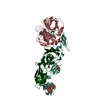
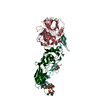
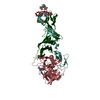
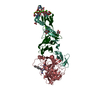
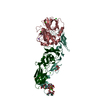
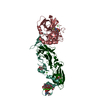
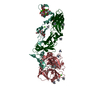
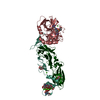
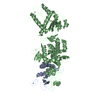
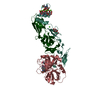
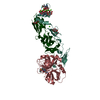
 PDBj
PDBj












